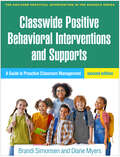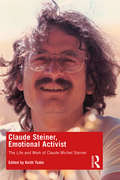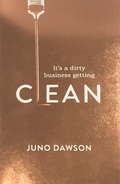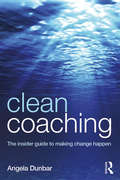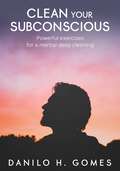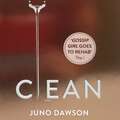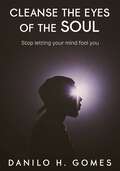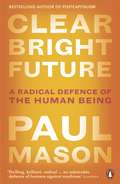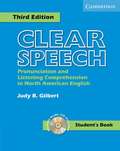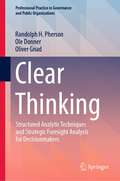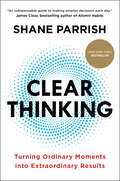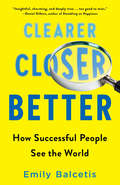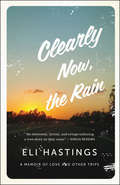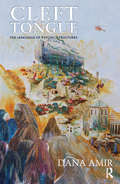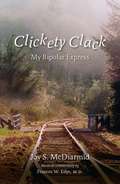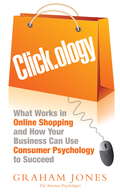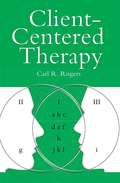- Table View
- List View
Classwide Positive Behavioral Interventions and Supports: A Guide to Proactive Classroom Management (The Guilford Practical Intervention in the Schools Series)
by Diane Myers Brandi SimonsenNow in a revised and updated second edition addressing the evolving needs of today's K–12 educators, this established classroom resource is written by leaders in positive behavioral interventions and supports (PBIS). Brandi Simonsen and Diane Myers provide a vital classroom management and behavior support toolkit with a primary focus on universal (Tier 1) support. In a convenient large-size format, the book provides step-by-step guidelines for structuring the classroom environment, actively engaging students in instruction, setting clear expectations, and implementing a continuum of strategies to reinforce positive behavior and respond to inappropriate behavior. Teacher-friendly features include classroom vignettes, bulleted chapter objectives, end-of-chapter learning activities, and reproducible forms that can be downloaded for repeated use. New to This Edition Expanded focus on culturally responsive and inclusive practice. Increased attention to connecting with students and families and engaging them in designing, implementing, and monitoring practices. More coverage of integrating Tier 2 and Tier 3 interventions into a classwide PBIS model. Updated research, resources, tools, and examples throughout the chapters. This book is in The Guilford Practical Intervention in the Schools Series, edited by Sandra M. Chafouleas.
Claude Lévi-Strauss
by Maurice GodelierOne of the world's leading anthropologists assesses the work of the founder of structural anthropologyAnthropologist Claude Lévi-Strauss was among the most influential thinkers of the 20th century. In this rigorous study, Maurice Godelier traces the evolution of his thought. Focusing primarily on Lévi-Strauss' analysis of kinship and myth, Godelier provides an assessment of his intellectual achievements and legacy. Meticulously researched,Claude Lévi-Strauss is written in a clear and accessible style. The culmination of decades of engagement with Lévi-Strauss' work, this book will prove indispensible to students of Lévi-Strauss' thought and structural anthropology more generally.
Claude Steiner, Emotional Activist: The Life and Work of Claude Michel Steiner
by Keith TudorThis book describes the work and life of Claude Michel Steiner, a close colleague and friend of Eric Berne, the founder of transactional analysis. Steiner was an early and influential transactional analyst, an exponent of radical psychiatry, and the founder of emotional literacy. Steiner also contributed a number of theories and concepts to the psychological literature. The book comprises edited excerpts from his unpublished autobiography, “Confessions of a Psychomechanic”, alongside commentaries and critical essays from colleagues on his major contributions to the fields of psychology, transactional analysis, radical therapy, and emotional literacy. Topics covered include script theory and the theory of strokes, recognition hunger, radical therapy, and the concept of power, and emotional literacy and love. In assessing Steiner’s various contributions, the book also identifies central themes and considers the autobiographical nature of theory. This unique collection demonstrates not only the range of Steiner’s insights but also his importance to the wider field and will be essential reading for practitioners and trainees alike.
Clay in the Age of Bronze
by Sofaer JoannaStudies of creativity frequently focus on the modern era yet creativity has always been part of human history. This book explores how creativity was expressed through the medium of clay in the Bronze Age in the Carpathian Basin. Although metal is one of the defining characteristics of Bronze Age Europe, in the Carpathian Basin clay was the dominant material in many areas of life. Here the daily experience of people was, therefore, much more likely to be related to clay than bronze. Through eight thematic essays, this book considers a series of different facets of creativity. Each essay combines a broad range of theoretical insights with a specific case study of ceramic forms, sites or individual objects. This innovative volume is the first to focus on creativity in the Bronze Age and offers new insights into the rich and complex archaeology of the Carpathian Basin.
Clayworks in Art Therapy: Plying the Sacred Circle
by David HenleyClay is universally recognized as a medium of creative expression, and it also has great potential for therapeutic application. These two properties of clay are celebrated together in a book that explores the history, theory and techniques of claywork in eliciting therapeutic outcomes. Vignettes and case material explain and expand the text, which interweaves an appreciation of clay in art with many practical suggestions for its use in therapy. By according equal status to aesthetic outcomes and artistic integrity, the author offers a new and holistic approach to claywork. Practitioners and educators in the fields of therapy and art will find his book to be an essential source of information and ideas.
Clean
by Juno DawsonWhen socialite Lexi Volkov almost overdoses, she thinks she's hit rock bottom. She's wrong.Because rock bottom is when she's forced into an exclusive rehab facility.From there, the only way is up for Lexi and her fellow inmates, including the mysterious Brady.As she faces her demons, Lexi realises love is the most powerful drug of all ... It's a dirty business getting clean.Addiction, redemption, love and despair. Clean is Gossip Girl meets Girl, Interrupted, and it will have you hooked from the very first page. 'I loved it' Marian Keyes'One to just enjoy' Stylist'An emotional freight train of a novel' Heat 'As bold and gritty as it is fabulously glossy and readable' Observer
Clean Coaching: The insider guide to making change happen
by Angela DunbarMost coaches today see their role as mainly non-directive, helping to uncover their coachee’s own wisdom. However, coaches may unwittingly and unconsciously constrain what their coachees talk and think about, getting in the way of unique, self-generated solutions. Clean Coaching provides a different, simple yet highly effective approach to one-to-one facilitation. It is a style, strategy and set of techniques that help coachees gain insight and make changes through discovering more about their own ‘insider’ perspective: of themselves and the world around them. Through the use of specifically-phrased, structured coaching questions, the coach’s own biased perspectives are stripped from their language, ensuring the coachee’s unique personal experience is honoured. In Clean Coaching, Angela Dunbar explains how this approach works in practical terms, with descriptions of how to structure a Clean Coaching session and the steps to take within such a session. The book gives detailed descriptions of the kinds of questions to ask and provides a wealth of analogues, examples and case studies to bring the descriptions alive, offering a clear blueprint for action. In addition, the book explains where Clean Coaching has come from, describing the development of Clean Language and other "Clean" approaches by the psychologist and psychotherapist David Grove. It also tracks how "Clean" approaches have been adopted and adapted by other practitioners. Dunbar draws on current research in the fields of developmental, neurological, cognitive and social psychology to demonstrate why Clean Coaching works so successfully. Exploring Clean Coaching in detail, and informed by both research and practice, this book will be a valuable resource for coaches at all levels, including executive coaches and those in training, as well as managers and executives acting in a coaching capacity.
Clean Your Subconscious: Powerful exercises for a mental deep cleaning
by Danilo H. GomesYour subconscious could be full of limiting beliefs, traumas, negative self concepts, and other kinds of dirt. Throughout life, our minds insist on archiving the most varied types of information. This resource would be wonderful if it wasn't for one defect: we memorize and give meaning in the wrong, and harmful way! As a consequence, we become prisoners of ourselves. CLEAN YOUR SUBCONSCIOUS presents the reader with a little bit about the vast world of the human mind, on top of practical and effective strategies to alter, or eliminate harmful information present in the subconscious. Free yourself from your inner dictatorship, and reach your goals!
Clean: The London Collection
by Juno DawsonFall into the lives of the city's filthy rich with Juno Dawson's deliciously dark and intoxicating London Collection. When socialite Lexi Volkov almost overdoses, she thinks she's hit rock bottom. She's wrong.Because rock bottom is when she's forced into an exclusive rehab facility.From there, the only way is up for Lexi and her fellow inmates, including the mysterious Brady.As she faces her demons, Lexi realises love is the most powerful drug of all ... It's a dirty business getting clean.Addiction, redemption, love and despair. Clean is Gossip Girl meets Girl, Interrupted, and it will have you hooked from the very first page.
Cleanse the Eyes of the Soul: Stop letting your mind fool you
by Danilo H. GomesBook about cognitive distortions, examples and solutions. The eyes are the gateway to the soul. As the years go by, our perceptions of life become blurred. Things cease to be as they really are in our perceptions and become what the mind wants us to see. The mind, in turn, is directly influenced by traumas and/or limiting beliefs. There is a way to free ourselves from these interferences of the mind over awareness. The book CLEANSE THE EYES OF THE SOUL reveals to the reader distortions that overshadow the beauty of life. Through this journey of self-awareness you will find the right ways to deal with these mind tricks. The book describes each distortion, brings examples and possible solutions. Free yourself from soul blindness and invest in your mental health.
Clear Bright Future: A Radical Defence of the Human Being
by Paul MasonA passionate defence of humanity and a work of radical optimism from the international bestselling author of PostcapitalismHow do we preserve what makes us human in an age of uncertainty? Are we now just consumers shaped by market forces? A sequence of DNA? A collection of base instincts? Or will we soon be supplanted by algorithms and A.I. anyway?In Clear Bright Future, Paul Mason calls for a radical, impassioned defence of the human being, our universal rights and freedoms and our power to change the world around us. Ranging from economics to Big Data, from neuroscience to the culture wars, he draws from his on-the-ground reporting from mass protests in Istanbul to riots in Washington, as well as his own childhood in an English mining community, to show how the notion of humanity has become eroded as never before.In this book Paul Mason argues that we are still capable - through language, innovation and co-operation - of shaping our future. He offers a vision of humans as more than puppets, customers or cogs in a machine. This work of radical optimism asks: Do you want to be controlled? Or do you want something better?
Clear Speech: Pronunciation and Listening Comprehension in North American English (3rd Edition)
by Judy B. GilbertThis book is designed to help students make the most efficient use of their time as they learn to pronounce English better.
Clear Thinking: Structured Analytic Techniques and Strategic Foresight Analysis for Decisionmakers (Professional Practice in Governance and Public Organizations)
by Randolph H. Pherson Oliver Gnad Ole DonnerThis book enables analysts in government and the private sector as well as policy advisors and decision makers to assess global risks and opportunities systematically, make well-founded and informed decisions, and anticipate the unanticipated. The authors illuminate the basics of intuitive and analytical thinking and how structured techniques can mitigate the impact of cognitive biases, misapplied heuristics, and intuitive traps. Three case studies illustrate how to apply over 30 Structured Analytic Techniques (SATs) with step-by-step instructions. The final chapter focuses on how to optimize the impact of your analytic product, be it a paper, briefing, or digital display.
Clear Thinking: Turning Ordinary Moments into Extraordinary Results
by Shane ParrishFew things will change your trajectory in life or business as much as learning to think clearly. Yet few of us recognize opportunities to think in the first place.You might believe you&’re thinking clearly in the moments that matter most. But in all likelihood, when the pressure is on, you won&’t be thinking at all. And your subsequent actions will inevitably move you further from the results you ultimately seek—love, belonging, success, wealth, victory. According to Farnam Street founder Shane Parrish, we must get better at recognizing these opportunities for what they are, and deploying our cognitive ability in order to achieve the life we want.Clear Thinking gives you the tools to recognize the moments that have the potential to transform your trajectory, and reshape how you navigate the critical space between stimulus and response. As Parrish shows, we may imagine we are the protagonists in the story of our lives. But the sad truth is, most of us run on autopilot. Our behavioral defaults, groomed by biology, evolution, and culture, are primed to run the show for us if we don&’t intervene. At our worst, we react to events without reasoning, not even realizing that we&’ve missed an opportunity to think at all. At our best, we recognize these moments for what they are, and apply the full capacity of our reasoning and rationality to them.Through stories, mental models, and more, Parrish offers the missing link between behavioral science and real-life outcomes. The result is a must-have manual for optimizing decision-making, gaining competitive advantage, and living a more intentional life.
Clearer, Closer, Better: How Successful People See the World
by Emily BalcetisSuccessful people literally see the world differently. Now an award-winning scientist explains how anyone can leverage this &“perception gap&” to their advantage. &“Get ready for this book to change how you see everything you see."—Adam Grant, New York Times bestselling author of Originals and Give and Take When it comes to setting and meeting goals, we may see—quite literally—our plans, our progress, and our potential in the wrong ways. We perceive ourselves as being closer to or further from the end than we may actually be depending on our frame of reference. We handicap ourselves by looking too often at the big picture and at other times too long at the fine detail. But as award-winning social psychologist Emily Balcetis explains, there is great power in these misperceptions. We can learn to leverage perceptual illusions if we know when and how to use them to our advantage. Drawing on her own rigorous research and cutting-edge discoveries in vision science, cognitive research, and motivational psychology, Balcetis offers unique accounts of the perceptual habits, routines, and practices that successful people use to set and meet their ambitions. Through case studies of entrepreneurs, athletes, artists, and celebrities—as well as her own colorful experience of trying to set and reach a goal—she brings to life four powerful yet largely untapped visual tactics that can be applied according to the situation. Narrow your focus: Closing the aperture of your attention helps you exercise effectively, save money, and find more time in your day. Widen the bracket: Seeing the forest instead of the trees reduces temptations and helps you recognize when a change of course is in order. Materialize your plan and your progress: Creating checklists and objective assessments inspires better planning and adjusts your gauge of what&’s really left to be done. Control your frame of reference: Knowing where to direct attention improves your ability to read others&’ emotions, negotiate better deals, foster stronger relationships, and overcome a fear of public speaking. A mind-blowing and original tour of perception, Clearer, Closer, Better will help you see the possibilities in what you can&’t see now. Inspiring, motivating, and always entertaining, it demonstrates that if we take advantage of our visual experiences, they can lead us to live happier, healthier, and more productive lives every day.
Clearing Emotional Clutter: Mindfulness Practices for Letting Go of What's Blocking Your Fulfillment and Transformation
by Donald AltmanA Fresh Start to a Healthy Emotional LifeIs emotional clutter blocking success in your personal and professional life? You’ve likely heard about the psychological benefits of clearing out the clutter in your surroundings, but how do you handle your emotional clutter - the psychological version of the jam-packed closet or impenetrable garage? Shutting away and trying to hide old pains and traumas creates toxic patterns that can keep you from having the life of your dreams. Integrating mindfulness and cutting-edge neuroscience, international mindfulness expert Donald Altman teaches how to modify entrenched habits and patterns with only a few minutes of attention daily.Altman first helps you realize what your baggage consists of and how to transform or jettison it. He then shows how to avoid the daily danger of accumulating new emotional clutter. No matter how fraught your life or relationships may be, you can cleanse, heal, or accept the old wounds, mistakes, and disappointments. With Altman’s lifestyle tools, you’ll discover how to address your past, better deal with the present, and cultivate the best possible future. Start fresh with Clearing Emotional Clutter.
Clearing the Fog: From Surviving to Thriving with Long Covid—A Practical Guide
by James C. Jackson&“An essential guide&” (Mark Hyman, author of Young Forever) to navigating life with the cognitive and mental health impairments that often accompany Long Covid. Early in the Covid-19 pandemic, the shocking mortality figures obscured the fact that death is not the only adverse outcome of the virus. Today, as many as 30 percent of Covid-19 survivors still experience symptoms long after their acute illness has passed, with cognitive and mental health problems especially prominent. For long haulers, this struggle with Long Covid has irrevocably changed their lives. Many have lost their ability to work, attend school, and look after their children. They often feel misunderstood and dismissed by others. Their once-full lives are now filled only with doctors' appointments that seem more and more futile. In Clearing the Fog, neuropsychologist Dr. James C. Jackson offers people suffering from Long Covid and their families a roadmap to help them manage their &“new normal.&” Focusing on cognitive impairment and mental health issues, he shows readers: The ways in which they can manifest and disrupt Suggestions for how and when to seek professional evaluations Science-based treatment options and strategies, Information on navigating health care systems and disability insurance Validation and hope as patients wrestle with their new diagnosis In addition, Dr. Jackson shares his own experience with chronic illness, relating to long haulers with vulnerability and compassion. Through moving stories as well as hands-on guidance, Clearing the Fog will help long haulers understand their current situation while offering multiple ways to address it, make sense of it, and move through it with the goal of thriving instead of merely surviving.
Clearly Now, the Rain: A Memoir of Love and Other Trips
by Eli HastingsThis memoir of a relationship with a self-destructive woman is &“as elemental, lyrical and cringe-inducing a love story as they come&” (Kirkus Reviews). Suspenseful, darkly funny, and devastating, this is Eli Hastings&’s true story of his troubled, decade-long relationship with his friend Serala. At family events, Serala wore saris and ate delicately from plates of curry. But elsewhere, she wore a lip ring, designer shades, and a cowboy hat; would regularly drink frat boys under the table; would sleep less than five hours a week; and would place herself in dangerous situations for another bag of heroin. Serala&’s complex character and seemingly haphazard choices are brought to vivid life, from ill-advised quests for narcotics in Mexican border towns to unplanned fifty-hour road trips from Los Angeles to New York City. Although her dark and traumatic journey concluded tragically at age twenty-seven, Hastings writes with a sense of hope and tenderness in this &“drug, romance and adventure-filled&” memoir of their unique relationship (The Seattle Times). &“An unflinching account of how it feels to be young and flirting with the abyss in America. The narrator&’s observations as he and his friends ride rough across the U.S.A., all pulled to orbit around their friend, lover, and lost soul, Serala, are also an investigation into the dangerously different ways that people respond to addiction. This is an elegy, yes, as if told by a boy who began his quest tutored by Kerouac&’s ghost, but became, on this hard road, a man schooled in love by the spirit of the Dalai Lama.&” —Rachel Rose, author of Giving My Body to Science
Cleft Tongue: The Language of Psychic Structures
by Dana AmirThis book is an attempt to analyse psychic language and its diverse modes of expression, both within psychic structure and in the interpersonal realm. It begins by looking at two basic forms of delay in the development of psychic language: concrete language, which is based on flattening, and pseudo-language, which is rooted in concealment. The next chapter focuses on the split between voice and meaning which marks psychotic syntax, and the latter's double function in defending the self against an unconscious death wish. The subject of the third chapter is the chameleon language of perversion, and the relationship between the perverse structure and the primal scene. This chapter is followed by one that suggests understanding autistic syntax as an inverse use of the psychic musical 'organ point'. The fifth chapter discusses the absent function of the inner witness in traumatic language. The sixth chapter discusses psychosomatic language through the distinction between metaphorical, metonymical and psychotic bodily expressions.
Clicker Fun: Dog Tricks and Games Using Positive Reinforcement
by Deborah JonesThis book introduces the basics of Clicker training and Operant Conditioning, and introduces a variety of games and tricks, that you can do as a beginning trainer, or in a dog training class you teach as a professional. The book also includes information on costumes, desensitization, and offers a course outline for a "Clicks and Tricks" course.
Clickety Clack: My Bipolar Express
by Joy S. McdiarmidClickety Clack is Joy McDiarmid’s self- portrait of bipolar mental illness and one of the most ambiguous sexual identities imaginable for a woman coming of age in the 1950s. Amidst gender and sexuality confusion, this Winnipeg woman began to look for romantic love and sexual fulfillment: sometimes wanting to dress as a man, sometimes as a woman, sometimes attracted to men, sometimes to women. In candid accounts of this paralysing complexity, which McDiarmid tried valiantly to understand and express despite oppressive social stigmas and parental strictures, her insights about human sexuality and "living the lie" are startling even in this age of open commentary about sex. Along primitive frontiers of treatment for bipolar disorders and dramas of shock therapy in psychiatric wards, entire years of McDiarmid’s life would slip by even as earlier years were being erased from her memory. Yet there came triumphant accomplishments in her competitive and stimulating world of advertising, university work, private enterprise, photography, travel, touring in her MG sports car, skilful tennis, and love. Such juxtaposed experiences of despair and defiant courage, supplemented at the end of each chapter with medical commentary by Joy’s psychiatrist Dr. Frances Edye, make Clickety Clack a rare road map to life.
Clickology
by Graham JonesOnline shopping continues to grow at an astounding rate: in 2012, more than $1 trillion was spent in online retailers alone. The nature of shopping is drastically changing, but with so little information on how best to interact with online customers, how are businesses to succeed?With Click.ology, internet psychologist Graham Jones has filled that gap. Through years of research into Internet psychology and online consumer habits, Jones has written the first how-to of its kind for online businesses. With his C.L.I.C.K. system, businesses will learn the crucial ways in which online shopping differs from traditional brick-and-mortar salesmanship and how to tweak their websites to avoid the dreaded "abandoned shopping cart." Jones tackles tricky psychological subjects such as priming customers for a certain price point and the social aspect of online shopping in a way that makes his strategies easy to implement. In addition to these essential tips, Jones investigates the fast-paced future of ecommerce and what businesses can do to stay ahead of the game. In an online world where customers make their choices in a matter of seconds, Click.ology distills the essentials every company in the online economy needs to know in order to turn clicks into dollars.Graham Jones is an Internet psychologist who helps businesses understand the online behavior of their customers and website visitors. He was one of the first psychologists in the world to start investigating the way human behavior has adapted to the online world. He lives in the United Kingdom.
Clickology: What Works in Online Shopping and How Your Business can use Consumer Psychology to Succeed
by Graham JonesThe world of shopping is at a crossroads. While online sales are growing at runaway speed, many businesses are finding themselves left behind, discovering that what has worked so long in offline does not work online, and what works online does not necessarily translate offline: it simply doesn't click. Packed with tips, guidance and real-world case studies from online niche stores Bellabox and Facetache to the universal appeal of Groupon, and from offline discount stores Dollar Tree and Poundland to the luxury Selfridges in this informative book internet psychologist Graham Jones reveals: *Why most online shopping carts are abandoned before a purchase is ever made and how to stop this happening in your store *Why having a centrally positioned search box aids navigation and increases sales *Why offering free shipping online pays off * Why it makes sense to be sociable He also reveals the why of consumer behaviour online, how it differs from offline behaviour, and how you can use this understanding to create a store that connects with and engages your customers on both a practical and a psychological level a store that demonstrates true clickology. Using an accessible five-step CLICK system for turning clicks into dollars, the book shows how to learn from the experience of both on- and offline, and apply lessons to both. Whether you re running a small business website or that of a big corporation, whether you're operating purely online or offline too, Clickology shows you how to thrive.
Client Centered Therapy (New Ed)
by Carl RogersIn this bestselling book, one of America's most distinguished psychologists crystallises the great progress that has been made in the development of the techniques and basic philosophy of counselling. Carl Rogers gives a clear exposition of procedures by which individuals who are being counselled may be assisted in achieving for themselves new and more effective personality adjustments.Contemporary psychology derives largely from the experimental laboratory, or from Freudian theory. It is preoccupied with minute aspects of animal and human behaviour, or with psychopathology. But there have been rebels, including Carl Rogers, Gordon Allport, Abraham Maslow, and Rollo May, who felt that psychology and psychiatry should aim higher, and be more concerned with growth and potentiality in man. The interest of such a psychology is in the production of harmoniously mature individuals, given that we all have qualities and possibilities infinitely capable of development. Successful development makes us more flexible in relationships, more creative, and less open to suggestion and control.This book is a mature presentation of the non-directive and related points of view in counselling and therapy. The final chapter presents a formal treatment of the psychological theory which is basic to the whole client-centered point of view, not only in counselling but in all interpersonal relations.This edition marks the 70th anniversary of first publication, and includes a new introduction from Rogers' granddaughter Frances Fuchs, PhD.
Client Centered Therapy (New Ed)
by Carl RogersIn this bestselling book, one of America's most distinguished psychologists crystallises the great progress that has been made in the development of the techniques and basic philosophy of counselling. Carl Rogers gives a clear exposition of procedures by which individuals who are being counselled may be assisted in achieving for themselves new and more effective personality adjustments.Contemporary psychology derives largely from the experimental laboratory, or from Freudian theory. It is preoccupied with minute aspects of animal and human behaviour, or with psychopathology. But there have been rebels, including Carl Rogers, Gordon Allport, Abraham Maslow, and Rollo May, who felt that psychology and psychiatry should aim higher, and be more concerned with growth and potentiality in man. The interest of such a psychology is in the production of harmoniously mature individuals, given that we all have qualities and possibilities infinitely capable of development. Successful development makes us more flexible in relationships, more creative, and less open to suggestion and control.This book is a mature presentation of the non-directive and related points of view in counselling and therapy. The final chapter presents a formal treatment of the psychological theory which is basic to the whole client-centered point of view, not only in counselling but in all interpersonal relations.This edition marks the 70th anniversary of first publication, and includes a new introduction from Rogers' granddaughter Frances Fuchs, PhD.
